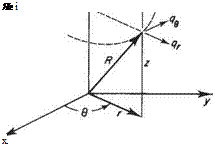Axisymmetric flows (inviscid and incompressible flows)
Consider now axisymmetric potential flows, i. e. the flows around bodies such as cones aligned to the flow and spheres. In order to analyse, and for that matter to define, axisymmetric flows it is necessary to introduce cylindrical and spherical coordinate systems. Unlike the Cartesian coordinate system these coordinate systems can exploit the underlying symmetry of the flows.
3.4.1 Cylindrical coordinate system
 |
The cylindrical coordinate system is illustrated in Fig. 3.27. The three coordinate surfaces are the planes z = constant and в = constant and the surface of the cylinder having radius r. In contrast, for the Cartesian system all three coordinate surfaces are
Fig. 3.27 Cylindrical coordinates
planes. As a consequence for the Cartesian system the directions (x, y, z) of the velocity components, say, are fixed throughout the flow field. For the cylindrical coordinate system, though, only one of the directions (z) is fixed throughout the flow field; the other two (r and 6) vary throughout the flow field depending on the value of the angular coordinate в. In this respect there is a certain similarity to the polar coordinates introduced earlier in the chapter. The velocity component q, is always locally perpendicular to the cylindrical coordinate surface and qg is always tangential to that surface. Once this elementary fact is properly understood cylindrical coordinates become as easy to use as the Cartesian system.
In a similar way as the relationships between velocity potential and velocity components are derived for polar coordinates (see Section 3.1.3 above), the following relationships are obtained for cylindrical coordinates
An axisymmetric flow is defined as one for which the flow variables, i. e. velocity and pressure, do not vary with the angular coordinate в. This would be so, for example, for a body of revolution about the z axis with the oncoming flow directed along the z axis. For such an axisymmetric flow a stream function can be defined. The continuity equation for axisymmetric flow in cylindrical coordinates can be derived in a similar manner as it is for two-dimensional flow in polar coordinates (see Section 2.4.3); it takes the form
![]() 1 drqr dqz r dr dz
1 drqr dqz r dr dz

![]()
The relationship between stream function and velocity component must be such as to satisfy Eqn (3.58); hence it can be seen that
3.4.2 Spherical coordinates











